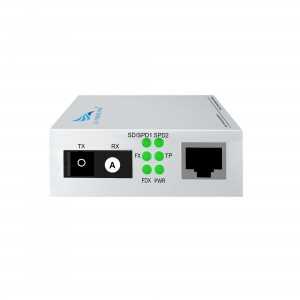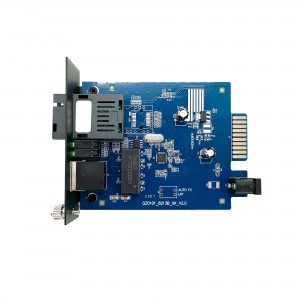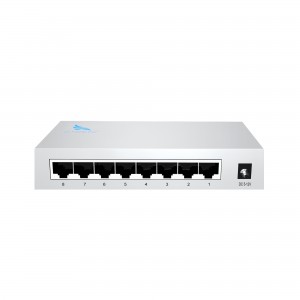3-port 10/100/1000M Media Converter (Single-mode Dual-fiber SC)
3-port 10/100/1000M Media Converter (Single-mode Dual-fiber SC)
Product Features:
Introduction to Optical Switching Transceivers: Revolutionizing Data Transmission
We are pleased to introduce our latest innovation – Optical Switch Transceiver, which is designed and developed by Huizhou Changfei Optoelectronics Technology Co., Ltd. As a global leader in providing total transmission solutions, our commitment to excellence has led to the creation of this cutting-edge product. marginal products. Relying on rich R&D experience and a wide range of photoelectric product research patents, the company has won wide acclaim from more than 360 distributors and agents in more than 100 countries around the world.
Optical switch transceivers combine the functionality of transceivers and optical switches, making them a versatile solution for seamless data transmission. The product is equipped with advanced optical and electrical features to ensure excellent performance and reliability. Whether you need to transmit data via optical or electrical signals, our innovative solutions can meet your needs.
Our optical switch transceivers feature a wide voltage power supply of DC5-12V, which provides flexibility and compatibility with various power systems. In addition, the port also supports 4KV lightning protection, which can ensure the safety of data transmission even in the face of power surges. The transceiver has wide temperature capability and can withstand extreme temperatures without compromising performance.
Our optical switch transceivers are specifically designed to meet modern data transmission requirements, supporting jumbo frame transmissions up to 10KB. This seamlessly transfers large files and data packets, saving you valuable time and resources. In addition, the product features low power consumption, ensuring energy efficiency without sacrificing functionality.
With its intuitive 4-digit dial and dynamic LED indicators, our optical switch transceivers are extremely user-friendly. Just plug and play, and you’re ready to go. The SC interface provides a safe and reliable connection to ensure the integrity of data transmission. Its iron case design and IP30 rating provide durability and resistance to harsh environments, making it suitable for a wide range of applications.
At Huizhou Changfei Photoelectric Technology Co., Ltd., we are committed to providing high-quality products and services. Our optical switching transceivers reflect our commitment to provide advanced transmission solutions to meet the changing needs of our customers around the world. With its single-mode dual-fiber capability, the product ensures seamless data transmission, enabling businesses to operate efficiently and effectively.
Upgrade your data transmission capabilities with optical switch transceivers from Huizhou Changfei Optoelectronics Technology Co., Ltd. Experience the difference in performance, efficiency and reliability our innovative solutions make. Trust our expertise and proven track record to take your data transfers to new heights. Contact us today and let us revolutionize the way you transfer data.
What This Product Does
◇ The CF-1022GSW-20 is a media converter designed to convert 1000BASE-X fiber to 1000Base-T copper media or vice versa. Designed under IEEE802.3ab 1000Base-T and IEEE802.3z1000Base-X standards, the CF-1022GSW-20 is designed for use with single-mode fiber cable utilizing the SC-Type connector. The CF-1022GSW-20 supports longwave laser specification at a full wire speed forwarding rate. It works at 1310nm on both transmitting and receiving data.
◇ Other features of this module include the ability to be used as a stand alone device (no chassis required), Auto MDI/MDI-X for TX port, and front panel status LEDs. The CF-1022GSW-20 will transmit at extended fiber optic distances utilizing single-mode fiber up to 20 kilometers.
Other Features
◇ In addition, the media converter can be used as a standalone device for automatic MDI/MDI-X in the TX port, where duplex mode is automatically negotiated.
technical parameter:
| Model | CF-1022GSW-20 | |
| Interface Characteristics | ||
| Fixed Port | 2* 10/ 100/ 1000Base-T RJ45 port
1* 1000Base-X uplink SC fiber port |
|
| Ethernet Port | 10/ 100/ 1000Base-T auto-sensing, full/half duplex MDI/MDI-X self-adaption | |
| Twisted Pair
Transmission |
10BASE-T: Cat3,4,5 UTP(≤100 meter)
100BASE-T: Cat5e or later UTP(≤100 meter) 1000BASE-T : Cat5e or later UTP(≤100 meter) |
|
| Optical Port | Default optical module is single-mode dual-fiber 20km, SC port | |
| Wavelength/Distance | single mode: 1310nm 0~40KM ,1550nm 0~120KM | |
| Chip Parameter | ||
| Network Protocol | IEEE802.3 10BASE-T, IEEE802.3i 10Base-T,
IEEE802.3u 100Base-TX, IEEE802.3u 100Base-FX, IEEE802.3x IEEE802.3ab 1000Base-T;IEEE802.3z 1000Base-X; |
|
| Forwarding Mode | Store and Forward(Full Wire Speed) | |
| Switching Capacity | 6Gbps | |
| Buffer Memory | 4.5Mpps | |
| MAC | 2K | |
|
LED Indicator |
Fiber | FX(green) |
| rate | SD/SPD1 (green)
SPD2: 100/1000 (green) |
|
| Data | TP1/TP2 (green) | |
| Power | PWR (green) | |
| Power | ||
| Working Voltage | AC:100-240V | |
| Power Consumption | Standby<1W, Full load<5W | |
| Power Supply | DC:5V/2A industrial power supply | |
| Lightning protection &Certification | ||
| Lightning protection | Lightning protection: 4KV 8/20us, Protection level: IP30 | |
| Certification | CCC;CE mark, commercial; CE/LVD EN60950;FCC Part 15 Class B; RoHS | |
| Physical Parameter | ||
| Operation TEMP | -20~+55°C;5%~90% RH Non condensing | |
| Storage TEMP | -40~+85°C;5%~95% RH Non condensing | |
| Dimension (L*W*H) | 94mm* 71mm*27mm | |
| Installation | Desktop | |
Product Size:
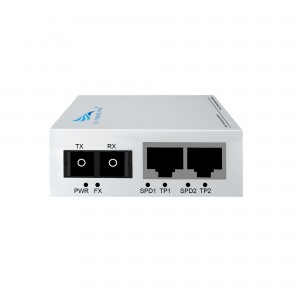
Product application diagra:

How to choose a fiber optic transceiver?
Optical fiber transceivers break the 100-meter limitation of Ethernet cables in data transmission. Relying on high-performance switching chips and large-capacity caches, while truly achieving non-blocking transmission and switching performance, they also provide balanced traffic, isolation and conflict. Error detection and other functions ensure high security and stability during data transmission. Therefore, fiber optic transceiver products will still be an indispensable part of actual network construction for a long time. So, how should we choose fiber optic transceivers?
1. Port function test
Mainly test whether each port can work normally in the duplex state of 10Mbps, 100Mbps and half-duplex state. At the same time, it should be tested whether each port can automatically select the highest transmission speed and automatically match the transmission rate of other devices. This test can be included in other tests.
2. Compatibility test
It mainly tests the connection ability between the optical fiber transceiver and other devices compatible with Ethernet and Fast Ethernet (including network card, HUB, Switch, optical network card, and optical switch). The requirement must be able to support the connection of compatible products.
3. Cable connection characteristics
Test the fiber optic transceiver’s ability to support network cables. First, test the connection ability of Category 5 network cables with lengths of 100m and 10m, and test the connection ability of long Category 5 network cables (120m) of different brands. During the test, the optical port of the transceiver is required to have a connection capability of 10Mbps and a rate of 100Mbps, and the highest must be able to connect to a full-duplex 100Mbps without transmission errors. Category 3 twisted pair cables may not be tested. Subtests can be included in other tests.
4. Transmission characteristics (transmission loss rate of data packets of different lengths, transmission speed)
It mainly tests the packet loss rate when the optical fiber transceiver optical port transmits different data packets, and the connection speed under different connection rates. For the packet loss rate, you can use the test software provided by the network card to test the packet loss rate when the packet size is 64, 512, 1518, 128 (optional) and 1000 (optional) bytes under different connection rates. , the number of packet errors, the number of packets sent and received must be more than 2,000,000. Test transmission speed can use perform3, ping and other software.
5. The compatibility of the whole machine to the transmission network protocol
It mainly tests the compatibility of fiber optic transceivers to network protocols, which can be tested in Novell, Windows and other environments. The following low-level network protocols such as TCP/IP, IPX, NETBIOS, DHCP, etc. must be tested, and the protocols that need to be broadcast must be tested. Optical transceivers are required to support these protocols (VLAN, QOS, COS, etc.).
6. Indicator status test
Test whether the status of the indicator light is consistent with the description of the panel and the user manual, and whether it is consistent with the current status of the fiber optic transceiver.








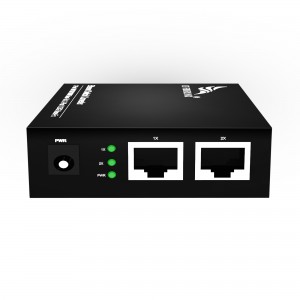
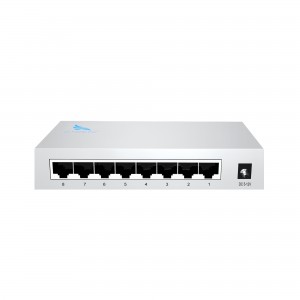
-300x300.jpg)
